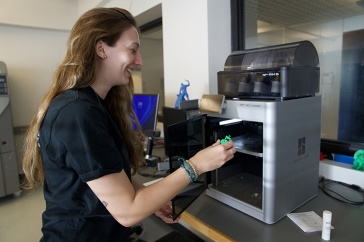
using one of the new biometric scanners.
New to the menu at UNH’s three dining halls: state-of-the-art technology that eliminates the use of ID cards for meal plan holders and provides the university with detailed information about dining hall traffic and usage. Over the summer, UNH Dining Services installed biometric finger-vein scanners at Holloway Commons, Stillings Hall and Philbrook Hall that read two unique markers — an individual’s finger print and his or her finger vein patterns — to identify students on the university’s meal plans. The technology is tied into Blackboard, the software system used by UNH and many other colleges and universities. UNH is the first institution to link the two systems together.
Biometric scanners are nothing new — UNH has had a hand scanning system in place for more than 10 years — but the new technology is significantly more sophisticated. To access the dining halls, students first must register with Dining Services, where both of their index fingers are scanned and their unique biometric profiles securely stored. For privacy purposes, the system does not create or store actual fingerprints. Instead, the scanning software takes measurements from every fingerprint and finger vein and creates an algorithm that converts each student’s data into a distinct mathematical value. Once registered, students simply place either index finger on one of the near-infrared scanners located at the entrance of each facility, which quickly “reads” the finger and matches the numeric value the scan creates to its database.
Rick MacDonald, director of Business Affairs, says the benefits are many. “The data that gets created in Blackboard is incredibly useful in helping us easily track who’s eating where and when to a degree that wasn’t possible before,” MacDonald says. “That in turn helps us much more efficiently distribute the revenue among the three dining halls and helps us understand our customers’ eating habits.” Also, because the system’s biometric measures are virtually impossible to counterfeit, students’ meal plans can’t be “borrowed” or shared with others who aren’t enrolled in one of the university’s meal plans. With some 11,000 students enrolled in the university’s meal plans, the majority of them with unlimited access to the dining halls, the savings potential is significant.
A total of nine scanners have been installed across the three dining halls — four in Holloway, three in Philbrook and two in Stillings — and MacDonald says the transition has been relatively smooth. “Like any technology, it takes a little getting used to, but students seem to have gotten the hang of it,” he says. One of the more common questions has been about whether the scanners are sanitary; MacDonald points out that they’re much like touching any other communal surface, such as a doorknob or PIN pad, and notes that there are hand sanitizer stations just inside all the dining halls and on all the turnstiles.
And of course, like Mom used to tell you, it’s always a good idea to wash your hands before before sitting down at the dinner table.
-
Written By:
Kristin Waterfield Duisberg | Communications and Public Affairs

















































